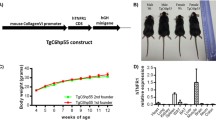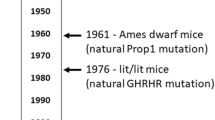Abstract
Effects of growth hormone (GH) overproduction were studied in transgenic mice expressing murine metallothionein I-GH fusion genes. The most obvious consequence was the acceleration of growth, which led to substantial increases in body weight of up to more than twice that seen in controls. Growth of the internal organs was stimulated, with hepatomegaly and nephromegaly as the most prominent features. GH transgene expression was also reflected in increased skeletal growth which affected various bones to different extents. The mean life-span of human GH transgenic mice with serum levels of hGH ranging from 3×103 to 9×105 ng/ml was drastically reduced at 160 days in both sexes. Severe renal lesions were the primary cause of the decrease in life expectancy and were characterized by marked nephron atrophy, obsolescence of numerous glomeruli, and a massive cystic dilation of the tubules. Initial changes involved the glomeruli, which showed significant enlargement and sclerotic lesions. The liver exhibited a pronounced hepatocellularmegaly and progressive degenerative as well as hyperplastic changes. One-third of the hGH transgenic animals displayed myocardial fibrosis. Hepatocellylar carcinoma was found in bovine GH transgenic mice older than 12 months. Our observations are compared with results of other investigators.
Similar content being viewed by others
References
Gordon JW, Scangos GA, Plotkin DJ, Barbosa A, Ruddle FH (1980) Genetic transformation of mouse embryos by microinjection. Proc Natl Acad Sci USA 77:7380–7384
Palmiter RD, Brinster RL (1985) Transgenic mice. Cell 41:343–345
Cuthbertson RA, Klintworth GK (1988) Transgenic mice — a gold mine for furthering knowledge in pathobiology. Lab Invest 58:484–502
Jaenisch R, Mintz B (1974) Simian virus 40 DNA sequences in DNA of healthy adult mice derived from preimplantation blastocysts injected with viral DNA. Proc Natl Acad Sci USA 71:1250–1254
Hammer RE, Pursel VG, Rexroad CE Jr, Wall RJ, Bolt DJ, Ebert KM, Palmite RD, Brinster RL (1985) Production of transgenic rabbits, sheep and pigs by microinjection. Nature 315:680–683
Brem G, Brenig B, Goodman HM, Selden RC, Graf F, Kruff B, Springmann K, Hondele J, Meyer J, Winnacker EL, Kräusslich H (1985) Production of transgenic mice, rabbits and pigs by microinjection into pronuclei. Zuchthygiene 20:251–252
Brem G (1990) Transgenic mice as disease models. Arzneimittelforsch (Drug Res) 40:335–343
Palmiter RD, Brinster RL (1986) Germ-line transformation of mice. Annu Rev Genet 20: 465–499
Costantini F, Lacy E (1981) Introduction of a rabbit β-globulin gene into the mouse germ line. Nature 294: 92–94
Brinster RL, Chen HY, Trumbauer ME, Yagle MK, Palmiter RD (1985) Factors affecting the efficiency of introducing foreign DNA into mice by microinjecting eggs. Proc Natl Acad Sci USA 82: 4438–4442
Hogan B, Costantini F, Lacy E (1986) Manipulating the mouse embryo. Cold Spring Harbor Laboratory, New York
DePamphilis ML, Herman SA, Martinez-Salas E, Chalifour LE, Wirak DO, Cupo DY, Miranda M (1988) Microinjecting DNA into mouse ova to study DNA replication and gene expression and to produce transgenic animals. BioTechniques 6: 662–679
Gordon JW, Ruddle FH (1983) Gene transfer into mouse embryos: production of transgenic mice by pronuclear injection. Methods Enzymol 101: 411–433
Hammer RE, Brinster RL, Palmiter RD (1985) Use of gene transfer to increase animal growth. Cold Spring Harb Symp Quant Biol 50: 379–387
Palmiter RD, Brinster RL, Hammer RE, Trumbauer ME, Rosenfeld MG, Birnberg NC, Evans RM (1982) Dramatic growth of mice that develop from eggs microinjected with metallothionein-growth hormone fusion genes. Nature 300: 611–615
Kägi JHR, Nordberg M (eds) (1979) Metallothionein. Birkhäuser, Basel
Cherian MG, Goyer RA (1978) Metallothioneins and their role in the metabolism and toxicity of metals. Life Sci 23: 1–10
Palmiter RD, Norstedt G, Gelinas RE, Hammer RE, Brinster RL (1983) Metallothionein-human GH fusion genes stimulate growth of mice. Science 222: 809–814
Swanson LW, Simmons DM, Arriza J, Hammer R, Brinster R, Rosenfeld MG, Evans RM (1985) Novel developmental specificity in the nervous system of transgenic animals expressing growth hormone fusion genes. Nature 317: 363–366
Hammer RE, Palmiter RD, Brinster RL (1984) Partial correction of murine hereditary growth disorder by germ-line incorporation of a new gene. Nature 311: 65–67
Behringer RR, Mathews LS, Palmiter RD, Brinster RL (1988) Dwarf mice produced by genetic ablation of growth hormone-epressing cells. Genes Dev 2: 453–461
Dudley GA, Portanova R (1987) Histochemical characteristics of soleus muscle in hGH transgenic mice. Proc Soc Exp Biol Med 185: 403–408
Bartke A, Steger RW, Hodges SL, Parkening TA, Collins TJ, Yun JS, Wagner TE (1988) Infertility in transgenic female mice with human growth hormone expression: evidence for luteal failure. J Exp Zool 248: 121–124
Brem G, Wanke R, Wolf E, Buchmüller T, Müller M, Brenig B, Hermanns W (1989) Multiple consequences of human growth hormone expression in transgenic mice. Mol Biol Med 6: 531–547
Celniker AC, Chen AB, Wert RM Jr, Sherman BM (1989) Variablity in the quantitation of circulating growth hormone using commercial immunoassays. J Clin Endocrinol Metab 68: 469–476
Wolf E, Brem G (1989) A comparison of different immunoradiometric assays for detecting hGH in the serum of MT-hGH transgenic mice and controls. Acta Endocrinol (Copenh) [Suppl] 120: 143–144
Hammer RE, Brinster RL, Rosenfeld MG, Evans RM, Mayo KE (1985) Expression of human growth hormone-releasing factor in transgenic mice results in increased somatic growth. Nature 315: 413–416
Shea BT, Hammer RE, Brinster RL (1987) Growth allometry of the organs in giant transgenic mice. Endocrinology 121: 1924–1930
Miller KF, Bolt DJ, Pursel VG, Hammer RE, Pinkert CA, Palmiter RD, Brinster RL (1989) Expression of human or bovine growth hormone gene with a mouse metallothionein-I promoter in transgenic swine alters the secretion of porcine growth hormone and insulin-like growth factor-I. J Endocrinol 120: 481–488
Vize PD, Michalska AE, Ashman R, Lloyd B, Stone BA, Quinn P, Wells JRE, Scamark RF, (1988) Introduction of a porcine growth hormone fusion gene into transgenic pigs promotes growth. J Cell Sci 90: 295–300
Quaife CJ, Mathews LS, Pinkert CA, Hammer RE, Brinster RL, Palmiter RD (1989) Histopathology associated with elevated levels of growth hormone and insulin-like growth factor I in transgenic mice. Endocrinology 124: 40–48
Orian JM, Lee CS, Weiss LM, Brandon MR (1989) The expression of a metallothionein-ovine growth hormone fusion gene in transgenic mice does not impair fertility but results in pathological lesions in the liver. Endocrinology 124: 455–463
Mayerhofer A, Weis J, Bartke A, Wagner TE (1990) Effects of transgenes for human and bovine growth hormones on age-related changes in ovarian morphology in mice. Anat Rec 227: 175–186
Mathews LS, Hammer RE, Behringer RR, D'Ercole AJ, Bell GI, Brinster RL, Palmiter RD, (1988) Growth enhancement of transgenic mice expressing human insulin-like growth factor I. Endocrinology 123: 2827–2833
Doi T, Striker LJ, Quaife C, Conti FG, Palmiter R, Behringer R, Brinster R, Striker GE (1988) Progressive glomerulosclerosis develops in transgenic mice chronically expressing growth hormone and growth hormone releasing factor but not in those expressing insulinlike growth factor-1. Am J Pathol 131: 398–403
Olson JL, Urdaneta AG de, Heptinstall RH (1985) Glomerular hyalinosis and its relation to hyperfiltration. Lab Invest 52: 387–398
Striker LJ, Doi T, Striker GE, (1990) Utilisation des animaux transgéniques en recherche néphrologique. In: Hamberger J (ed) Actualités néphrologiques. Flamarion Paris, pp 93–106
Brem G, Wanke R (1988) Phenotypic and pathomorphological characteristics in a half-sib-family of transgenic mice carrying foreign MT-hGH genes. In: Beynen AG, Solleveld HA (eds) New developments in biosciences: their implications for laboratory animal science. Martinus Nijhoff, Dordrecht, pp 93–98
Orian JM, Tamakoshi K, Mackey IR, Brandon MR (1990) New murine model for hepatocellular carcinoma: transgenic mice expressing metallothionein-ovine growth hormone fusion genes. J Natl Cancer Inst 82: 393–398
Messing A, Chen HY, Palmiter RD, Brinster RL (1985) Peripheral neuropathies, hepatocellular carcinomas and islet cell adenomas in transgenic mice. Nature 316: 461–463
Dilley RJ, Schwartz SM (1989) Vascular remodeling in the growth hormone transgenic mouse. Circ Res 65: 1233–1240
Selden RF, Yun JS, Moore DD, Rowe ME, Malia MA, Wagner TE, Goodman H (1989) Glucocorticoid regulation of human growth hormone expression in transgenic mice and transiently transfected cells. J Endocrinol 122: 49–60
Author information
Authors and Affiliations
Rights and permissions
About this article
Cite this article
Wanke, R., Hermanns, W., Folger, S. et al. Accelerated growth and visceral lesions in transgenic mice expressing foreign genes of the growth hormone family: an overview. Pediatr Nephrol 5, 513–521 (1991). https://doi.org/10.1007/BF01453693
Received:
Issue Date:
DOI: https://doi.org/10.1007/BF01453693




